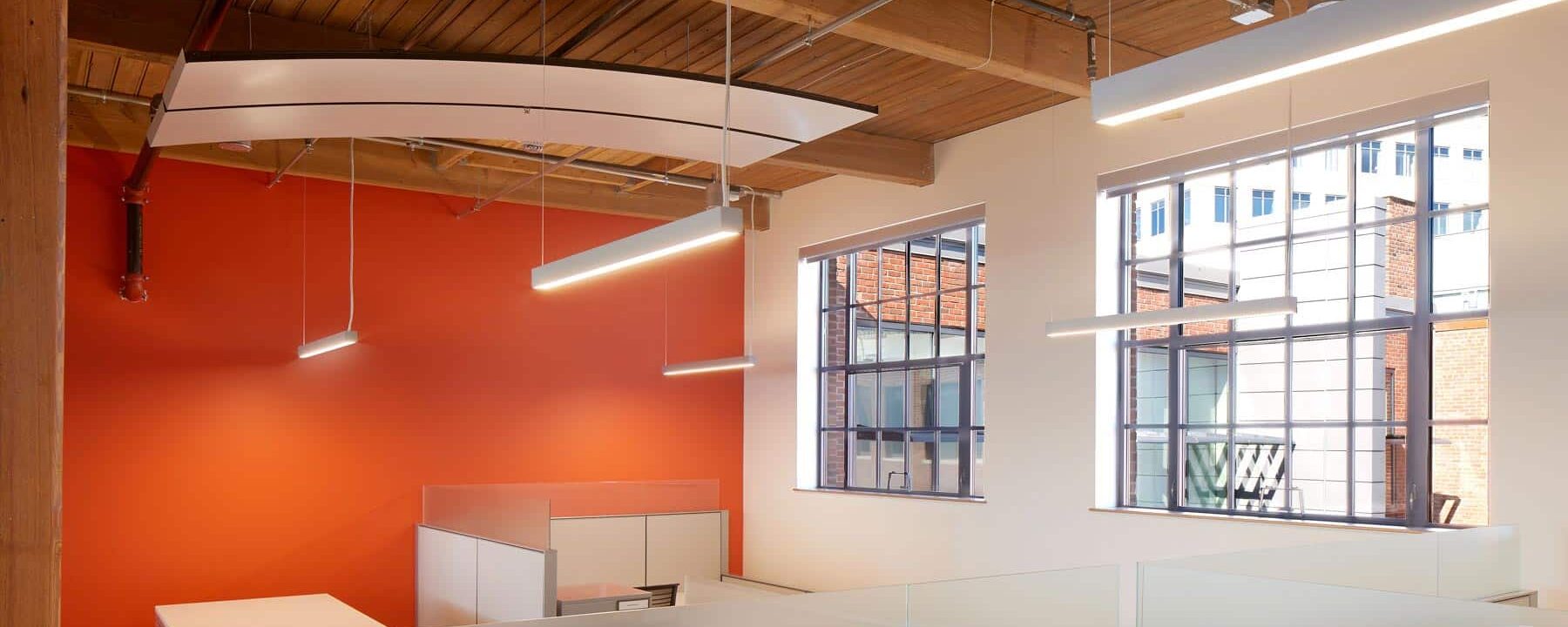Defining and Understanding Direct and Indirect Light
Let us first define these two types of luminaires by their distribution and then discuss each type’s pros and cons.
Direct Lighting
Direct lighting luminaires are the category of luminaires where the illumination distribution is in a specific direction. Direct lighting distribution provides higher illumination to task areas or direct accenting of objects in space. Samples of this Illumination are sunlight, task lighting, recessed down lighting, track lighting, linear down-lighting luminaires, linear wall wash luminaires, and troffers.
Advantages of Direct Lighting Distribution
- Direct lighting creates distinct shadows and makes the illuminated objects stand out to the viewer.
- When comparing equal lumen output to an indirect luminaire, direct lighting luminaires will deliver higher lumens on a given surface.
- Directing lighting lumens will make objects brighter and more focused, resulting in increased visual attraction for the viewer.
- Direct lighting meets the higher illumination levels in tasks and accent areas and increases both safety and security in the higher illuminated areas.
- Direct luminaires with integrated LED sources are compact, energy-efficient, and low maintenance.
- Direct luminaires with white light CCT tuning can change the Kelvin temperature of the light source and affect the mood of occupants in the illuminated space.
Disadvantages of Direct Lighting Distribution
- Direct lighting can create additional shadows and uneven light patterns, causing discomfort and confusion.
- Direct lighting can cause reflective glare in areas using visual screens, computer monitors, glass shelving displays, and glass-covered floor display cases.
- Direct lighting’s direct glare will add additional visual stress to the viewer. The use of dimming / diffused lenses can help reduce glare and lower eye fatigue when added as an option to the direct luminaire.
Indirect Lighting
The indirect lighting luminaires, in turn, spread out their illumination distribution over a larger area. An indirect luminaire lumen distribution is light towards a reflective surface. An indirect light source illuminates the space with a reflected uniform and softer light. This illuminated space will create an atmosphere where the viewer will feel light, comfortable, and hospitable. In commercial task lighting areas, office spaces, places of education, storage areas, and medical facilities, indirect light supports improved attention and awareness of the participants.
Samples of this kind of indirect Illumination are indirect sunlight, linear up-lighting luminaires, cove lighting, and wall washers.
Advantages of Indirect Lighting Distribution
- Indirect Illumination produces a more defused and evenly lit space, making the area more inviting.
- Indirect lighting reduces shadows and direct glare, which improves the viewer’s visual comfort in offices, libraries, and areas where visual reflector screens are used.
- Indirect lighting reduces eye fatigue.
- Indirect lighting adds depth to a space by creating soft, even, and diffused Illumination.
- Indirect lighting supports elderly vision by producing less glare.
- Indirect lighting adds additional Illumination to stairways and dark hallways, improving safety and security.
- Indirect lighting used in wall washing produces even low levels of Illumination on walls, ceilings, and floors, creating an inviting, peaceful feeling in residential, hotel lobbies, and hospital waiting rooms.
- Indirect luminaires with integrated LED sources are compact, energy-efficient, and low maintenance.
- Indirect luminaires with white light CCT tuning can change the Kelvin temperature of the light source and affect the mood of occupants in the illuminated space.
- The inclusion of a batwing diffuser creates a pattern that provides wide and even illumination.
Disadvantages of Indirect Lights
- Indirect luminaires need more reflected lumens to equal the same number of lumens on the task surface below as illuminated by a direct lighting luminaire.
- When using indirect Lighting, higher reflected ceiling paint/ceiling panels can improve efficiency.
Direct/Indirect Light Fixtures
A single luminaire can be designed to provide both direct and indirect lighting. These fixtures are direct/indirect luminaires and offer up and downlight distribution patterns. The downward light provides general illumination, while the upward light creates a softer ambient glow.
Specifying Direct and Indirect Fixtures
Luminaire designs are constantly evolving, but the fundamentals of light design remain consistent. No matter the style, or even lack of style, that a fixture brings to a design – the quality of the light applied to the space is essential.
Commercial spaces are typically replete with direct and indirect lighting luminaires. The combination of both, through dedicated direct or indirect features or the utilization of luminaires that provide both types of illumination, is typical in these facilities.
Linear fixtures are a commonly utilized style in these commercial settings because they are frequently suspended or wall-mounted with the ability to distribute light up, down, or both. Indirect uplight provides a soft glow but can feel incomplete or dull without the presence of downlighting, while downlight alone can be harsh and create glare without the offsetting touch of indirect light.
Other considerations when applying direct and direct light include the texture and color of the illuminated space’s ceiling, walls, and floors. Dark, textured, or even the popular trend of exposed ceilings may not provide the reflectivity required for the space. White walls and floors may provide too much reflectivity for a high percentage of direct downlights.

